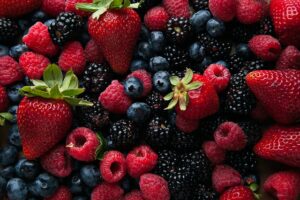HOW TO ENJOY A MODERATE GLYCEMIC LOAD DIET
As regular readers of GI News know, the glycemic index, or GI, is an inherent property of carbohydrate-containing foods and beverages. It is a relative ranking from 1–100, describing the rate at which available carbohydrate (total carbohydrate minus dietary fiber) is digested, absorbed and metabolised into glucose and released into the blood stream. Low GI foods (55 and under) are characterised by a slower and lower rise in blood glucose levels. High GI foods (70 and over) are characterised by a faster and higher rise and fall in blood glucose levels.
However, speed of digestion is only one part of the story. Quantity counts. How high blood glucose levels actually rise and how long they remain high after we consume a meal or drink containing available carbohydrate depends on both the amount of carbohydrate as well as its glycemic index. Researchers from Harvard University and the University of Toronto came up with a term to describe this “speed/quantity” combo: glycemic load (GL). It is calculated by multiplying the GI of a food by the available carbohydrate content (carbohydrates minus fiber in North America) in the serving (expressed in grams), divided by 100 (because GI is a percentage):
GL (grams) = GI ÷ 100 x available carbs (grams) per serving
For example, a typical medium-size apple has a glycemic index of 38 and contains 15 grams of available carbohydrate. Therefore, its glycemic load is 38÷100 × 15 = 6 grams, equivalent to 6 grams of pure glucose. If you are hungry, and the apples are particularly crispy, juicy, and delicious, and you eat two, the overall glycemic load of this snack is 12 grams. If you have three, it’s 18 grams, and so on.
- High GL foods and drinks have a GL value of 20 and above;
- Medium GL foods and drinks have a GL value between 11 and 19; and
- Low GL foods and drinks have a GL value of 10 and under.
In observational studies, GI and GL are calculated for the persons whole diet and adjusted for energy (kilojoules or calories) to help reduce confounding (e.g., the larger a person the more energy they require to maintain their body weight). Around the world, the average adult consumes around 2,000 calories (8,400 kilojoules) each day, so this is commonly used as the standard comparator.
Because GL is the product of GI and available carbohydrate, you can reduce it by either consuming a low GI diet (e.g., aim for an average GI less than 45), or by consuming less available carbohydrate (e.g., aim for between 130–230 grams per day if you consume 2000 calories (8400 kilojoules) per day), or both.
For example, for people who typically consume a relatively high carbohydrate diet (e.g., greater than 230g per day) with a high average GI (greater than 70), your average daily GL would be greater than 160 g. Reduce your average daily available carbohydrate intake to 165 g and GI to 45 for an average daily GL of less than 80 g per 2000 calories, which as discussed in Food for Thought, is considered a moderate GL diet. An example meal plan could look something like this:
| Meal | Glycemic load (GL) |
| Breakfast | |
| ½ Cup Swiss muesli and ½ Cup reduced fat milk | 17 |
| 1 lady finger banana | 7 |
| Lunch | |
| 1 cheese and salad sandwich made with multigrain bread | 12 |
| 2 Medjool dates | 13 |
| Dinner | |
| Fish with two low(er) GI potatoes (e.g., Carisma, Marfona, Nadine, Nicola), carrots and green beans | 20 |
| 1 glass red wine | 0 |
| ½ Cup yoghurt with fresh fruit | 5 |
| Total glycemic load | 74 |
As can be seen from this example, following a low GI and moderate GL diet doesn’t mean you have to stop enjoying all of the carbohydrate-containing foods that you love.
Read more:
- Salmerón J, and colleagues. Dietary fiber, glycemic load, and risk of non-insulin-dependent diabetes mellitus in women. JAMA. 1997.
- Ebbeling, C and colleagues. Effects of a low-carbohydrate diet on insulin-resistant dyslipoproteinemia-a randomized controlled feeding trial. AJCN. 2021

Dr Alan Barclay, PhD, is a consultant dietitian and chef with a particular interest in carbohydrates and diabetes. He is author of Reversing Diabetes (Murdoch Books), and co-author of 30-plus scientific publications, The Good Carbs Cookbook (Murdoch Books), Managing Type 2 Diabetes (Hachette Australia) and The Ultimate Guide to Sugars and Sweeteners (The Experiment Publishing).
Contact: Follow him on Twitter, LinkedIn or check out his website.








